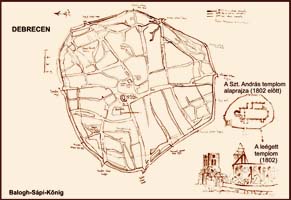 The political and economic life of the town Debrecen was determined in the second half of the XVIth century by its geographical situation, being a town of the Hungarian kingdom lying closest to Transsylvanian Prinicpality. Trade routes avoiding the Hungarian territories under Turkish occupation were meeting in Debrecen, resulting a flourishing economioc and
The political and economic life of the town Debrecen was determined in the second half of the XVIth century by its geographical situation, being a town of the Hungarian kingdom lying closest to Transsylvanian Prinicpality. Trade routes avoiding the Hungarian territories under Turkish occupation were meeting in Debrecen, resulting a flourishing economioc and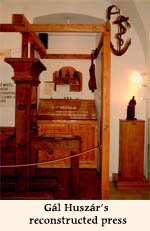 commercial life. Debrecen was an estate of the family Török of Enying and actually a market town which could preserve its independent status although paying taxes to the Transsylvanian Princes, to the Hungarian king and to the Osman invaders.
commercial life. Debrecen was an estate of the family Török of Enying and actually a market town which could preserve its independent status although paying taxes to the Transsylvanian Princes, to the Hungarian king and to the Osman invaders.
By the time printing was introduced in Debrecen, Calvinist church had an overwhelming power in the town dominating both over Lutheranism, Antitrinitarianism and Catholicism. This was mainly due to the activity iof Peter Melius Calvinist bishop of Debrecen (1558-1572). In Debrecen it was Melius who realized the agitating power of printing.
From this aspect it was at the right time that the protestant preacher and printing press owner Gál Huszár took refuge in Debrecen. From the time he set up his printing shop in 1561, printing was continuous in the town until today.

GÁL HUSZÁR IN DEBRECEN (1561–1562)
As a protestant preacher following Philiph Melanchthon Gál Huszár belonged to the first generation of reformation. His aim was to spread his religious conviction not only through teaching, preaching but also as an author and printer. It was especially his printing activity because of which he had to escape from the authority of catholic bishop and move from one place to the other. Thanks to his successful rescue from the prison at Kassa he settled in Debrecen, as his printing equipment was saved, he could set up his press. His safety was guaranteed by the town council of Debrecen. In return, Gál Huszár offered his service as a printer.
|
|
Title pages of the Debrecen community song book by Gál Huszár (RMNy 160) |
The first product of his press in Debrecen was the protestant community song book the printing of which was begun years earlier in Óvár, and continued in Kassa. This book is not only the first product of the Debrecen printing offive but also the first protestant community song book in Hungarian lanuage. The song book had also printed musical notations. It was dedicated by Huszár to the Calvinist bishop of Debrecen, To Peter Melius.
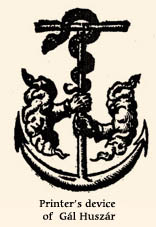 The first printing was soon followed by others (RMNy 169, RMNy 171, RMNy 181), mostly polemic works by Melius against Antitrinitarians. Early the next year, 1562, he began to print the confession of Eger, although it was not finished by him, as he decided to return to western Hungary, to Komárom, and serve as a preacher.
The first printing was soon followed by others (RMNy 169, RMNy 171, RMNy 181), mostly polemic works by Melius against Antitrinitarians. Early the next year, 1562, he began to print the confession of Eger, although it was not finished by him, as he decided to return to western Hungary, to Komárom, and serve as a preacher.
It can be deduced that when leaving Debrecen, he did not take his whole printing equipment with himself, but donated it to the town - thus making it jpossible, to find a printer and continue issuing books in Debrecen. It was very likely the Calvinist bishop Peter Melius who made efforts to make the printing activity continuous in the town.

MIHÁLY TÖRÖK IN DEBRECEN (1562–1568)
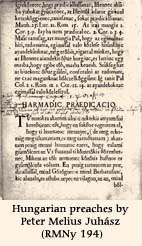 After Gál Huszár leaving Debrecen and the arrival of the new printer Mihály Török almost a year passed, nevertheless, it seems that some unknown and rather unpractised printer or printers were continuing work.
After Gál Huszár leaving Debrecen and the arrival of the new printer Mihály Török almost a year passed, nevertheless, it seems that some unknown and rather unpractised printer or printers were continuing work. 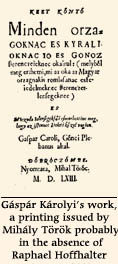 The products coming out from the Debrecen press in the course of 1562 are of poorer quality than before (RMNy 176, RmNy 177, RMNy 178).
The products coming out from the Debrecen press in the course of 1562 are of poorer quality than before (RMNy 176, RmNy 177, RMNy 178).
The first book the imprint of which mentions the name of Mihály Török ios the preaches by Peter Melius in Hungarian (Magyar prédikációk, RMNy 194). We have no data as to the former activity of Mihály Török, where he studied, or where he came from. Although he began printing alone, he was soon helped by another printer, when the prominent Vienna printer Rudolph Hoffhalter arrived in Debrecen. Frjom 1563 on Hoffhalter took part in book producing making use of his own printing equipment, he took with him to Debrecen.

RAPHAEL HOFFHALTER IN DEBRECEN (1563–1565)
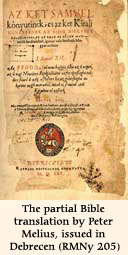 In the second half of the 16th century Debrecen's political and economic life was determined by the fact that it was bordered by Transylvania, the occupied territories and royal Hungary under Habsburg rule. It was following the Turkish occupation that he town's economic significance increased, as it was crossed by the North-South and East-West trade routes. Local merchants managed to sell their goods all over Europe, from Brasov to Augsburg, and from Danzig to Istambul. In the crest Raphael Hoffhalter made for Debrecen in 1563, he included the image of Péter Melius Juhász, a leading Calvinist priest. Reformation spread among the citizens of Debrecen in the late 1530s, while by the 1550s the Helvetian form of Reformation had become more pronounced. During his activity there, Melius (1558-1572) fought bitterly both with Catholics and Unitarians (also called Anti-Trinitarians). He realised that for the effective spreading of his tenets, the town needed a press. Thus fleeing with his typography, Gál Huszár arrived in Debrecen at the most appropriate moment. He was the first printer to establish his trade in Debrecen for a very long time to come.
In the second half of the 16th century Debrecen's political and economic life was determined by the fact that it was bordered by Transylvania, the occupied territories and royal Hungary under Habsburg rule. It was following the Turkish occupation that he town's economic significance increased, as it was crossed by the North-South and East-West trade routes. Local merchants managed to sell their goods all over Europe, from Brasov to Augsburg, and from Danzig to Istambul. In the crest Raphael Hoffhalter made for Debrecen in 1563, he included the image of Péter Melius Juhász, a leading Calvinist priest. Reformation spread among the citizens of Debrecen in the late 1530s, while by the 1550s the Helvetian form of Reformation had become more pronounced. During his activity there, Melius (1558-1572) fought bitterly both with Catholics and Unitarians (also called Anti-Trinitarians). He realised that for the effective spreading of his tenets, the town needed a press. Thus fleeing with his typography, Gál Huszár arrived in Debrecen at the most appropriate moment. He was the first printer to establish his trade in Debrecen for a very long time to come.
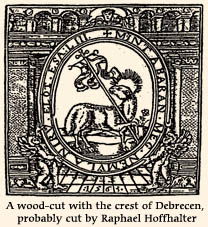 At first keeping his name secret, Raphael Hoffhalter continued book printing in Debrecen as started by Gál Huszár. That as early as 1563 he was already in Debrecen is testified by Péter Melius Juhász's: Book of Hungarian sermons (RMNY 194). In it we already find the sharper contoured Antique font imported from Vienna by Hoffhalter, who at this point still wished to stay anonymous. When Hoffhalter understood that in the name of the Empire's interests Emperor Maximillian II, who had earlier favoured Protestants, did not support followers of the new faith, his only aim was to flee with the printing equipment indispensable for his living. He was probably taking advantage of the Pozsony celebrations of Maximillian's coronation as king of Hungary, when he collected the stocks of his Vienna typography and returned to Debrecen. In 1564 he modernised some of the stocks his predecessor Gál Huszár had left behind in Debrecen, and in 1565 he published under his own name his Debrecen prints with the newly developed font. Some of the most beautiful and best known of his works are the edition of the Hungarian translation of István Werbőczy's code called Tripartitum and Melius's partial translation of the Bible.
At first keeping his name secret, Raphael Hoffhalter continued book printing in Debrecen as started by Gál Huszár. That as early as 1563 he was already in Debrecen is testified by Péter Melius Juhász's: Book of Hungarian sermons (RMNY 194). In it we already find the sharper contoured Antique font imported from Vienna by Hoffhalter, who at this point still wished to stay anonymous. When Hoffhalter understood that in the name of the Empire's interests Emperor Maximillian II, who had earlier favoured Protestants, did not support followers of the new faith, his only aim was to flee with the printing equipment indispensable for his living. He was probably taking advantage of the Pozsony celebrations of Maximillian's coronation as king of Hungary, when he collected the stocks of his Vienna typography and returned to Debrecen. In 1564 he modernised some of the stocks his predecessor Gál Huszár had left behind in Debrecen, and in 1565 he published under his own name his Debrecen prints with the newly developed font. Some of the most beautiful and best known of his works are the edition of the Hungarian translation of István Werbőczy's code called Tripartitum and Melius's partial translation of the Bible.

ANDRÁS KOMLÓS [LUPULUS] (1569–1575)
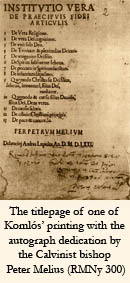 In the second half of the 1560s the confessional hostility was gradually deepening between the Calvinsts and the Unitarians (Antitrinitarians). In this Peter Melius the Calvinist bishop of Debrecen and Ferenc Dávid the preacher of the Transylvanian Prince János Zsigmond took the leading part with their pamphlets.
In the second half of the 1560s the confessional hostility was gradually deepening between the Calvinsts and the Unitarians (Antitrinitarians). In this Peter Melius the Calvinist bishop of Debrecen and Ferenc Dávid the preacher of the Transylvanian Prince János Zsigmond took the leading part with their pamphlets.
Although printing began in Debrecen in 1560, it seems that in 1568, because of the death of the printer, nothing has left the printing shop of the town. Therefore, Peter Melius had to order his notes on the Gyulafehérvár religous dispute of March 1568 to be printed in Kolozsvár at the prominent printing shop of the Gáspár Heltai (RMNy 256). For a short time the Calvinists in Debrecen were left without a press: the local press was out of use and in Kolozsvár the printer-publisher Heltai joined the Unitarians. The long-expected, learned printer who in the second half of 1569 settled in Debrecen, was András Komlós.
There are no contemporary sources about the person of the new printer. As he had commercial contacts with the widow of the Kolozsvár printer-publisher Gáspár Heltai, book-historians supposed that he must have acquired his crafts there. Recent investigations have added new information as to his person: the book by Peter Károlyi: Az egy igaz Istenröl (RMNy 277) printed by Komlós bears his name in the imprint in the Latin form: „Andreas Lupulus.”
; In this same book the author mentions that the printer can not speak Hungarian. This is especially interesting, as formerly there were only books printed by him with his name in the Hungarian form „Komlós”– meaning „Lupulus” in Latin. So far the title page and the contents of this book was unknown to bibliographers, until lately the unique copy of the Sárospatak Calvinist College was retured by the Russian State to its owner.
Although the learned printer András Komlós had some own printing equipment, still, during his activity in Debrecen he used his own equipment and the one found in Debrecen, in the possession of the town, side by side. The equipment of the town of Debrecen consisted of the printing types and decorations left here by the first printer Gál Huszár, to which later the printing types and decorations of Raphael Hoffhalter were added. The products of Komlós' typography display a good knowledge of his craft especially in the first years of his activity, in 1569–1571. In the later years the level of his printings is poorer, especially in books issued without imprint.
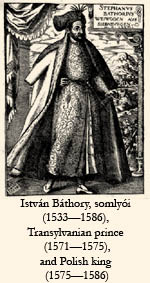 In his first years as the printer of the town Debrecen he took his part in the confessional debates with the Unitarians, on behalf of the Calvinist. In the course of these polemics the Calvinist church remained and strengthened in Debrecen, while with the death of the Transylvanian Prince János Zsigmond (1571), the Unitarians have lost their major patron. It was the censure patent of 17th Septermber 1571 issued by the new Transylvanian prince, the catholic István Báthory, later Polish king on the one side, and the death of the Calvinist Peter Melius (December 1572) on the other, which finally put an end to the series of religious polemic pamphlets. From this time on the Debrecen printer Komlós was mostly producing chronicles, verses, biblical stories: the majority of the 46 books printed by him to our knowledge, are mostly in Hungarian.
In his first years as the printer of the town Debrecen he took his part in the confessional debates with the Unitarians, on behalf of the Calvinist. In the course of these polemics the Calvinist church remained and strengthened in Debrecen, while with the death of the Transylvanian Prince János Zsigmond (1571), the Unitarians have lost their major patron. It was the censure patent of 17th Septermber 1571 issued by the new Transylvanian prince, the catholic István Báthory, later Polish king on the one side, and the death of the Calvinist Peter Melius (December 1572) on the other, which finally put an end to the series of religious polemic pamphlets. From this time on the Debrecen printer Komlós was mostly producing chronicles, verses, biblical stories: the majority of the 46 books printed by him to our knowledge, are mostly in Hungarian.
It was in 1575 that his name can be found last time on books printed in Debrecen. His work was followed by his widow, whose printings from the year 1577 exceed the level of the former ones. This remarkable circumstance is explained by the presence of a new printer, the young Rudolf Hoffhalter, who stayed in Debrecen from 1576 on, and took part in the work of the typography. He probably married the widow of András Komlós and thus became the new printer in Debrecen. He aquired the complete printing equipment of his predecessor which he continuously used, while the earliest printing types and decorations tracing back to Gál Huszár have disappeared, were no longer in use.
THE SERIES OF INITIALS USED BY KOMLÓS |
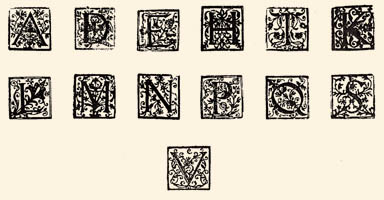 |
|
PRINTING TYPES FROM THE EQUIPMENT OF KOMLÓS |
|
|
CHARACTERISTIC ORNAMENTS USED BY KOMLÓS |
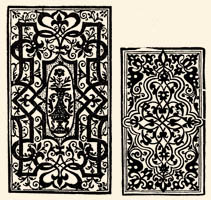 |
|

HOFFHALTER RUDOLF (1576-1587)
 |
View of Debrecen, woodcut |
Rudolf the son of Raphael Hoffhalter -- a prominent printer and woodcutter of Polish origina and playing a significant part in 16th century printing history of Hungary -- was baptized in Zurich, 7th December 1550. 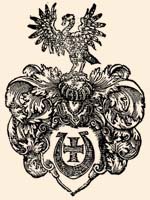 His godmother was Margaretha Lavater daughter of the famous protestant personality Heinrich Bullinger. At the time his father Raphael Hoffhalter died he was 18, he has not reached his full age, consequently he did not follow his father in his
His godmother was Margaretha Lavater daughter of the famous protestant personality Heinrich Bullinger. At the time his father Raphael Hoffhalter died he was 18, he has not reached his full age, consequently he did not follow his father in his 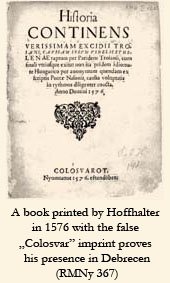 office as a printer in Gyulafehérvár (Alba Iulia, RO). It was later, in 1573-1574 that he began printing in southern Hungary near the rivers Mura and Dráva at the estate of his patron the protestant magnate Miklós Bánffy. In 1574 he moved to the nearby Nedelic (Drávavásárhely, CR) where he set up his press on the estate of György Zrínyi.
office as a printer in Gyulafehérvár (Alba Iulia, RO). It was later, in 1573-1574 that he began printing in southern Hungary near the rivers Mura and Dráva at the estate of his patron the protestant magnate Miklós Bánffy. In 1574 he moved to the nearby Nedelic (Drávavásárhely, CR) where he set up his press on the estate of György Zrínyi.
Next year, in 1575 he left the region of the rivers Dráva-Mura and returned to Transylvania. First he turned his attention to the newly erected (rather re-erected) printing shop in Szeben (Sibiu, RO). However, it was only a major part of his printing equipment inherited from his father that remained in Szeben - they were present in Szeben printings from 1575 well into the 17th century - Hoffhalter himself soon left the Transylvanian Saxon town and tried to settle in Kolozsvár (Cluj, RO). Here, following the death of Caspar Heltai, founder of the press, the widow was successfully coping with the task. Finally, in 1576 Rudolf Hoffhalter settled in Debrecen, where his first printing was probably the rhymed history of Paris and Helena (RMNy 367), although printed without his name and with false "Colosvar" imprint. Despite the Kolozsvár imprint the types as well as the watermark of the paper prove that its actual printer was Rudolf Hoffhalter. It was only his woodcut family crest and a renewed printing type that he brought to Debrecen, but the local printing shop was well equipped, as it can be judged from the products of the press from the time of the former city printer's widow. She was helped by the competent printer Rudolf Hoffhalter whom she soon married. With this marraige Hoffhalter was following Komlós in his office as city printer. 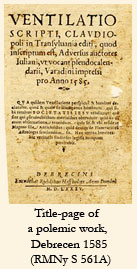 The first Hungarian
The first Hungarian 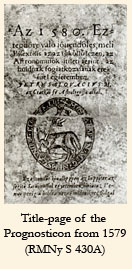 Aritmetica (RMNy 378) issued in 1577 bears already Hoffhalter's name as the printer of Debrecen. During the nearly ten years of his activity in Debrecen Calvinist song-book, historical chronicles and Biblical histories were among the products of this press.
Aritmetica (RMNy 378) issued in 1577 bears already Hoffhalter's name as the printer of Debrecen. During the nearly ten years of his activity in Debrecen Calvinist song-book, historical chronicles and Biblical histories were among the products of this press.
At an interval between 1584-1585 Rudolf Hoffhalter left Debrecen for Várad (where his father had been working for some time, twenty years before). While he stayed in Várad, printing activity in Debrecen ceased. His press produced three printings in Várad (RMNy 559, RMNy 560, RMNy 572). In 1585 he returned to Debrecen, where the next year he began to print the New Testament in Tamás Félegyházi's translation (RMNy 584). He could not finish it, because he died in 1587 and it was finally issued by his widow. The printing shop continued under her guidance until August 1590.
|
Decorated initials newly acquired by Hoffhalter and surviving also in later printings from Debrecen |
Similarly to his father, Rudolf Hoffhalter was also familiar with letter casting as well as with woodcutting. His craft as a woodcutter is demonstrated by the crest of Debrecen representing the lamb with flag placed in a fine renaissance hall. This woodcut often occurring on his title-pages bears the date of its making 1583 and it is actually a recut variant made by his father twenty years before. When making preparations for his last great work of printing the New Testament translation he acquired a new series of decorated initials. The equipment of printing types and ornaments were still present and used by the Debrecen city press at the beginning of the 17th century. Both father and son, the two Hoffhalters had a great impact on printing in Hungary: not only through the contents of their altoghether fifty printings but also through their fine renaissance graphic art.
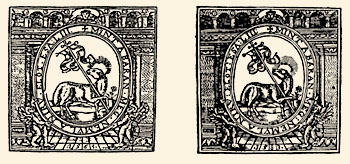 |
The two variants of the woodcut crerst of the town Debrecen from 1563 and 1583 |

THE WIDOW OF RUDOLF HOFFHALTER (1586-1590)
After the death of Rudolf Hoffhalter it was his widow who continued to lead the printing shop, while she was helped by János Csáktornyai as senior printer. From the time between 1586-1590 the press produced - without giving the name of the printer a rhymed history (RMNy 608), a verse chronicle (RMNy 593) and a catechism by Tamás Félegyházi (RMNy 609)
 |
Tail-piece acquired by Hoffhalter and surviving in the Debrecen press even after his death
|

JÁNOS CSÁKTORNYAI (1590-1595)
It was after the death of Rudolf Hoffhalter that he was appointed to lead the printing shop in Debrecen. Judging from his name he was probably in the company of Hoffhalter when working in the region of river Mura and followed him to Debrecen. In 1590 Csáktornyai invited Salamon Sultzer letter caster to renew the already worn types of the city press. While he was in charge of the printing shop he issued a new edition of Gergely Szegedi's protestant song book (RMNy 640), several text-books like Balázs Szikszai Fabricius' Nomenclatura (RMNy 642) and the Latin text book by Sebald Heyden with Hungarian interpretations (RMNy 658), further Erasm's essay on moral (RMNy 656) and Cato's Libellus elegantissimus (RMNy 659) with only the first words of the title in Latin, otherwise in Hungarian.
|
|
RMNy 656 |
RMNy 659 |
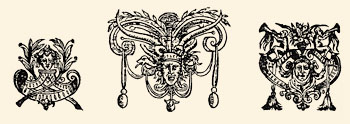 |
Hoffhalter's newly acquired tail-pieces |

PÁL RHEDA OF LIPSIA (1596-1619)
The next printer in Debrecen following Csáktornyai was, according to his name, probably of Lipsian (Leipzig) origin, a learned printer of scholarly education. He began his career as the head of the Debrecen printing shop in 1596 and the majority of his activity falls to the first two decades of the 17th century.


<<back to the top <<

LITERATURE:
BÁNFI Szilvia: Huszár Gál távozása Debrecenből, és nyomdakészletének további sorsa. = MKSz 1986. 1-16.
BENDA Kálmán-IRINYI Károly: A négyszáz éves debreceni nyomda. 1561-1961. Bp.
CSÜRÖS Ferenc: A debreceni városi nyomda története. Debrecen 1911.
V. ECSEDY Judit: A régi magyarországi nyomdák betűi és díszei 1473-1600. Bp. 2004. 385-401.